
Are Environmental Toxins Haunting Our Kids?
October is Children's Environmental Health Month
Quick Summary
- October is Children’s Environmental Health Month and there are many environmental hazards and toxins that kids are exposed to daily that are far more frightening than ghosts and ghouls.
- There are over 80,000 chemicals used in the toy market, most of which have not been regulated or studied.
- Environmental degradation and stresses have a direct impact on children's health. Children are more susceptible to chemical exposures due to their unique biological makeup and boundless curiosity for the world.
Ghosts and ghouls aren’t the only things children should be scared of during the spooky Halloween season. October is Children’s Environmental Health Month. There are many environmental hazards and toxins that kids are exposed to daily that are far scarier than ghosts and ghouls, and many are invisible to parents.
Why is children's environmental health important?
In a recent fact sheet, the American Public Health Association (APHA) reported that children under five bear around 88% of the global disease burden due to Climate Change. Research reported in the journal Science found that “children today will face around three times as many climate disasters as their grandparents did, including wildfires, storms, floods, and droughts” (detailed here). Water scarcity, air pollution, and lead pollution are just a few environmental crises that can dramatically affect children’s health.
Children breathe, drink, and eat more per kilogram of body weight than adults. This results in greater exposures per kilogram of body weight to any contaminants in the air, water, or food compared with adults. Anything unsafe that children touch, eat, or breathe may affect them more than adults because, when comparing pound to pound, their contact with these toxins is higher.
Hundreds or more likely thousands of studies have demonstrated that greater contact with harmful environmental substances in early developmental stages, including in the womb, correlates with a higher likelihood of developing diseases and developmental disorders like intellectual disability or ADHD.
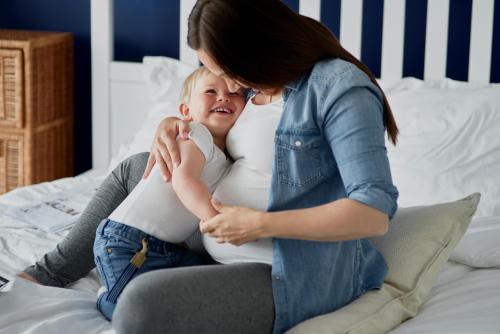
A recent study found that air pollution accounts for 20% of newborn deaths worldwide. A study on Prenatal exposures to PBDEs, fire retardants used for many years in furniture foam, carpets, wire insulation, and plastic casings for electronics, linked these compounds with neuro-developmental effects. A study looking at pesticide exposure and its effect on growth in children 8-12 years old concluded that “pesticide exposure could be a risk factor for the occurrence of growth disorders in children living in agricultural areas. Necessary actions should be taken to protect children.” NIEHS (National Institute of Environmental Health Sciences)-funded research has also linked chemical exposures to certain childhood cancer.
What makes children more susceptible?
Children, specifically younger kids, are more susceptible to chemical exposures due to their unique biological makeup and boundless curiosity about the world. Crawling, ‘mouthing’ toys, and personal hygiene habits increase exposure to chemical and environmental toxins, especially for infants and toddlers. Children have a higher surface area-to-volume ratio when compared to adults.
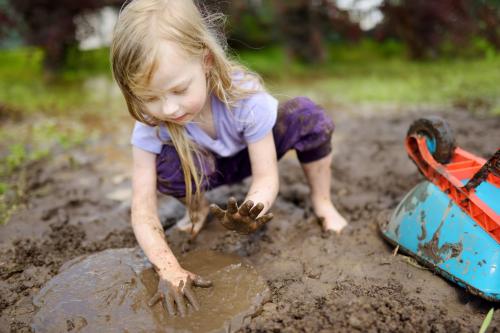
Young children also cannot distinguish “food” from “nonfood.” The prolonged consumption of “nonfood” is known as pica. According to the Environmental Protection Agency (EPA), it is estimated that young children consume between 0.2 to 0.8 grams of dirt per day, which may become a problem if, for instance, the dirt is contaminated with lead or had been recently sprayed with pesticides. These behaviors become an issue when they happen frequently: sucking on their thumb or eating dirt on the playground can become a source of ingesting toxins on a daily basis and can potentially lead to health concerns down the road.
Some children may be more susceptible to environmental toxins simply based on where they live. According to an NIH article, “Children living at or below the poverty line who live in older housing are disproportionately at greatest risk of lead poisoning.” In 1978, lead paints were banned, yet until recently plumbing used in residences could contain up to 8% lead and still be labeled as “lead-free.” Contamination of low-income housing (known as ‘projects’) built half a century ago with leaded paint has left a legacy of lead poisoning for generations of residents, who have historically been primarily Black, according to the PEW Organization.
Where do you find environmental toxins?
The table below shows commonly ingested environmental toxins that can be consumed by children and where it is common to find them in households.
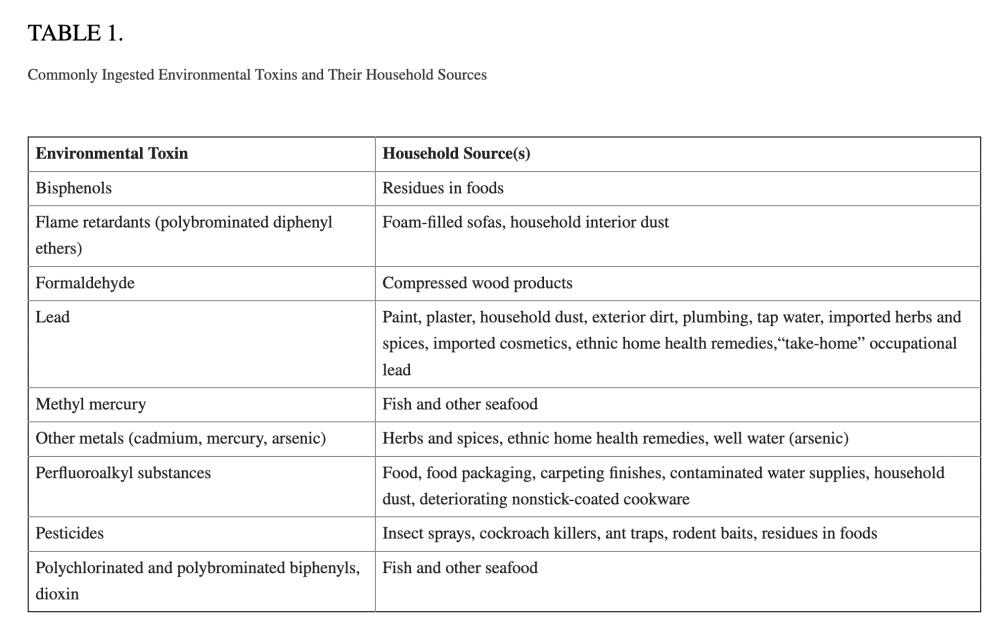
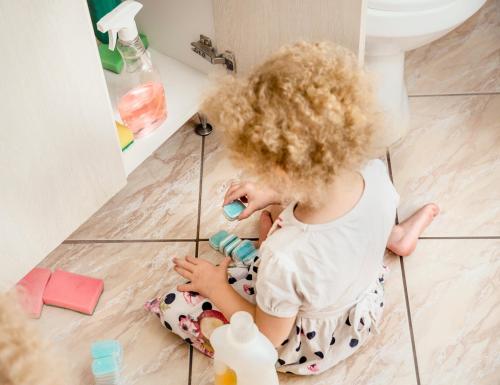
One group of compounds that have not received as much attention is the quaternary ammonium compounds (QACs). QACs are a group of chemicals designed to kill germs and bacteria. QACs are widely used in pesticides, detergents, disinfectants, and personal care products like toothpaste, shampoo, and eye drops. One of the EHSC Pilot Award recipients – Dr. Gino Cortopassi (working with Sandipan Datta) – recently received an NIEHS grant to further study toxic effects of QACs. In the study, dose-response, time course, and biodistribution studies of QACs are proposed as effectors of lung toxicity.
When shopping for a child’s toys, it is common to focus on the recipient, the age, and interests. Parents might check to see if a toy has sharp edges or could otherwise hurt their child, but it is probably less often that people consider: “Hey, does this toy have toxins in it? What happens if my child chews or sucks on parts of it?” A study by the UN Environment Program (UNEP) stated that 25% of children’s toys contain harmful chemicals. The study shares that developers use these chemicals to provide specific levels of hardness, elasticity, and fire retardancy. According to the UNEP, toxins in children’s products are widely available but not obvious to the general public unless they have studied or read about the chemicals present in these toys. We Act shares the same sentiments. In an article, they share that in an EPA (Environmental Protection Agency) toy toxicity study, “it was reported that toxic chemicals, including BPA, arsenic, cadmium, and mercury, were noted in their report over 11,000 times.” These foundations and programs urge that these chemicals be phased out and replaced with safer alternatives.
In addition to QACs and pesticides, according to an NIH study currently, there are over 80,000 chemicals used in the toy market, most of which have not been regulated or studied. Toys, furniture, imported cookware, and makeup could contain trace amounts of lead or mercury.
What can you do to protect children from these environmental exposures?
In addition to monitoring the ingredients of children’s toys, the SDG (Sustainable Development Group) notes that children’s rooms should have plenty of ventilation to avoid unnecessary exposure from inhaling these toxic substances found in toys. Numerous regulations worldwide require tags to contain ingredients and limit what ingredients are allowed in children's toys, yet these tags often just list complex chemicals that are not commonly recognizable by most of the public. According to the Children's Environmental Health Network, many officials are working together to update regulations. They call for parents to educate themselves about these often invisible ghostly toxins and not just cut tags off and throw them out without a second thought.
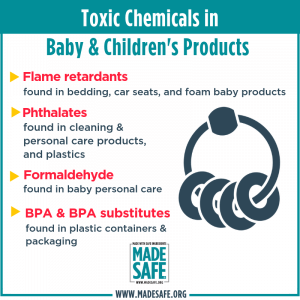
Since the majority of the population does not have the specific scientific-technical knowledge needed to decipher these tags, there needs to be a switch to labeling that is clear and understandable. One option is, Made Safe, which has an easy-to-navigate ingredient database where parents can type in jargon from a label and get a simple explanation of the substance.
The FDA and US Food and Drug Administration have begun to release guidelines to prevent some of these unnecessary exposures. Some suggestions include: keeping shoes outside/ contained to one area with a new crawling toddler, sweeping and mopping daily to prevent dust buildup, and avoiding using pesticide sprays where children may be breathing or crawling.
We can’t all be experts, which is why it is imperative that our elected representatives require proper labeling in understandable language, as well as push for the removal of harmful substances from common household products. Many chemicals in our household products do not serve a necessary purpose, and they need no replacement. For those that do serve a needed purpose, a safer alternative should be identified to serve as the replacement.

Angelina is an EHSC editorial assistant for the communications department and an undergraduate student at UC Davis studying Human Development. She is an aspiring writer with a focus on science communication.